by Julie Lineback and Colton Campbell
The teenagers
Tony has spent his life running.
The 16-year-old – whose name has been changed – is on his high school’s track and football teams. Unfortunately, Tony got into some trouble last year and found himself in front of a judge instead of an offensive line.
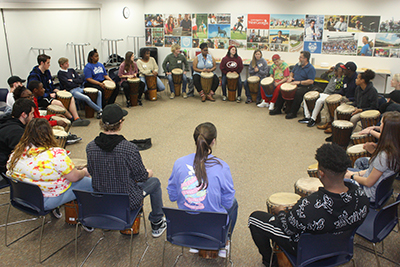 But now, thanks to a transformative mentoring program at the University of West Georgia,
Tony’s not running away from anything, but rather running toward something.
But now, thanks to a transformative mentoring program at the University of West Georgia,
Tony’s not running away from anything, but rather running toward something.
Parents of at-risk teens looking for an alternative to traditional behavior modification and treatment programs can receive assistance through the mentoring efforts of the students and faculty of UWG through the SPARK program, housed in the College of Education (COE).
The semester-long program – spearheaded by Dr. Thomas Peterson, professor in the COE – invites Peterson’s college students to weekly meetings with at-risk students ages 13 through 18 from local middle and high schools who have had at least one juvenile court appearance. During the meetings, COE students mentor the younger group, engaging them in hands-on activities to inspire positivity and hope for life.
This past semester, Tony was joined by another teenager who attends the same high school named Nate, whose name has also been changed.
Before he started the SPARK program, Nate suffered from social anxiety and stage fright.
“SPARK has helped me with lots of things, but especially with stress and talking in front of a crowd,” Nate said. “When I first came in, I was nervous because I didn’t think I could be myself around them. But then I realized everyone was there to see me succeed, and that allowed me to break out of my shell.”
Nate and Tony said they’ve learned numerous things after being in the SPARK program for a semester, including why they should withhold judgment when meeting someone new.
“The SPARK program opened my eyes,” Tony said. “I used to judge people and think that they had better, easier lives than me. Going to the program, I realized everyone has problems and that I should be open to everyone. Everyone is different, and I should be open to helping them out, instead of just thinking they have it all figured out.”
Nate said learning about how to establish and maintain interpersonal relationships has affected his daily life as well.
“SPARK taught me to be nice to people,” Nate said. “If they’re cruel or rude to you, that doesn’t mean you have to be cruel or rude to them back. It’s something I’m working on every day, and I’m better than I used to be. I used to be off the chain, but now I’ve settled down a lot. I think a lot of that has to do with how I see myself differently now. That helps a lot with my anger.”
Not only has the SPARK program changed Nate and Tony’s present circumstances. It’s changed their future, too.
Nate wants to be a counselor, and Tony wants to work in service to the community.
“I want to help people who don’t have everything,” Tony said. “This is just a small thing, but maybe they have old shoes. I want to go out and get them another pair of shoes. If I see someone going through a lot, I want to talk to them and figure out what’s going on and how I can help.”
The two teenagers know that realizing their aspirations will likely require a college degree. Thanks to one aspect of SPARK – during which college students share their life’s stories, focusing on struggles they’ve overcome to attend college – they can see themselves in post-secondary education.
“Hearing their stories made me look at the college students differently,” Nate said. “Before, I looked at them like they had everything, but in reality, they didn’t have everything. They had to do it themselves. That made me more open-minded to talk to them because it showed that we could relate on the level that all our lives have had struggles and challenges we’ve had to go through.”
The college professor
Dr. Thomas Peterson was raised to help those in need.
The son of a preacher, the family traveled to Singapore as missionaries when Peterson was 3 years old. He grew up in the Far East, witnessing poverty up close in places like Thailand, Vietnam and India.
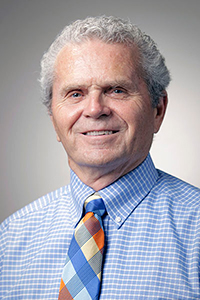 “I saw my dad out there helping those people in unfortunate circumstances,” he recalled.
“That really made an impact on me.”
“I saw my dad out there helping those people in unfortunate circumstances,” he recalled.
“That really made an impact on me.”
Those early travels paved the road to Peterson’s long career in influencing the lives of youth. He has been in education for more than 50 years, first serving as a public school teacher in California and Maryland then as a principal in North Carolina. He has been at UWG since 1991.
“I always knew I was making a difference, but I really wanted to do something radical and take a chance,” said Peterson, who is currently an assistant professor in the College of Education’s Department of Educational Technology and Foundations.
SPARK was born out of a conversation between Peterson and the late Judge Dan Camp in 2009. The two were discussing juveniles who appeared in Camp’s courtroom with ‘dead eyes’ – no direction and no goals.
Peterson saw this as the opportunity he’d been looking for, one that would serve a dual purpose.
“SPARK works in two areas,” he said. “It partners students who are going to be teachers with the youth in our area who are struggling. It’s a win-win situation.”
The program was designed unlike most traditional programs that are out to change the behavior of the participants.
“Most programs are designed to change them from the outside in, but not ours,” Peterson explained. “We are trying to get people to examine their own lives and think of themselves differently.”
At-risk youth are identified through the Department of Juvenile Justice. Peterson said he usually gets approximately 50 applicants a year and chooses a group of 15. When they show up to the program, neither Peterson nor his COE students know their backgrounds or why they were in the system.
“The kids will come in with their hoods up, creating barriers,” he said. “I tell my students, don’t take them down – they’ll come down on their own.”
And with the help of icebreakers, activities and inspirational guests in a nonjudgmental environment, the barriers do come down.
“We level the playing field between the COE students and the youth to help them learn and open up,” Peterson said. “We want to turn their pain and traumas into opportunities for helping other people.”
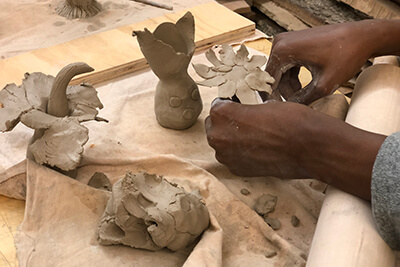 A crucial part of the 10-week program is COSMOS, a life-story sharing method that
helps to foster mutuality and cultivates an equal relationship between the younger,
school-aged participants and the older college students.
A crucial part of the 10-week program is COSMOS, a life-story sharing method that
helps to foster mutuality and cultivates an equal relationship between the younger,
school-aged participants and the older college students.
“COSMOS is a story about the influences of one’s life,” Peterson explained. “Think of it this way – I am the center of my cosmos, and everything swirls around me. Sometimes there are parallels that repeat themselves over and over again. By sharing their COSMOS, all participants are able to identify and relate.”
Since the two age groups aren’t separated by many years, peer mentorships can be fostered. The at-risk youth are able to see they do have futures after hardships, and Peterson’s COE students are able to prepare for their futures as educators.
Peterson cited a landmark study completed by the Council of State Governments Justice Center and Texas A&M University’s Public Policy Research Institute that coined the phrase “school-to-prison pipeline.” While it found that 23 percent of students who had been suspended at least once had contact with the juvenile justice system, fewer than 3 percent of students had broken rules that made suspension a required punishment, such as bringing weapons or drugs to school.
“I’ve seen so many kids suffering in classrooms, and the teachers don’t know how to deal with them,” he said. “SPARK is helping prepare them. It costs $78,000 a year to keep a kid in jail. For that we could hire two teachers who are prepared to meet those challenges.”
For Peterson, his work with SPARK isn’t much different than the work his father did years ago.
“There’s other ways to help people than the way I was brought up in,” he concluded. “It just takes some imagination. Someone has to break the mold. If some of my students become teachers who can alleviate the suffering, that’s the legacy I want to leave.”
The judge
Judge Thomas Parmer takes the juvenile code very seriously.
“We aren’t supposed to punish,” said Parmer, judge in the Juvenile Court of Carroll County, Georgia. “We are supposed to provide service, counseling, structure and certain things that will help prevent them from breaking the law again.”
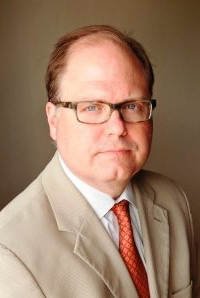 SPARK – a unique program that gives at-risk youths who have had at least one juvenile
court appearance a chance to experience positive peer intervention – was already underway
when Parmer was sworn in five years ago.
SPARK – a unique program that gives at-risk youths who have had at least one juvenile
court appearance a chance to experience positive peer intervention – was already underway
when Parmer was sworn in five years ago.
Peterson and the late Judge Dan Camp founded the program in 2009.
“It is a program for adolescents who, because of their history or family issue have been placed in a position where they have no hope, have turned to this behavior as an escape or a show of anger,” explained Parmer. “It opens up to them a new world of college, UWG and 18- 21-year-olds who have similar experiences as them that they can bond over.”
Parmer shared that the cases he sees primarily are delinquency – kids who have perpetrated a crime – and children in need of services – those who have committed status offenses such as truancy, runaways or are ungovernable in the home.
“Most of the members of the youth who end up in my juvenile court program go to SPARK,” he informed. “Probation sends teenagers to SPARK more than anyone.”
The other cases consist of those who have experienced abuse or neglect from their parents and have subsequently been removed from their homes. Parmer recently began sending youth from Alice’s House – a local nonprofit organization that provides a safe and secure environment for children of West Georgia – to a condensed summer SPARK program.
“These kids more than any need this because they need a view into what life can be and see that life can be enjoyable,” Parmer said. “Completely outside their control, they have been exposed to traumatic incidents that take any hope out of them.”
Without any sense of stability, and often being shuffled from place to place, many of these dependent children struggle to keep pace with their peers academically.
According to the National Foster Youth Institute, high school dropout rates are three times higher for foster youth than other low-income children, and only about 50 percent graduate from high school.
“Their educational opportunities are lessened,” Parmer informed. “They don’t care because so many other things have happened to them. They deserve for us to do everything we can to show them that they can do something and motivate them for success.”
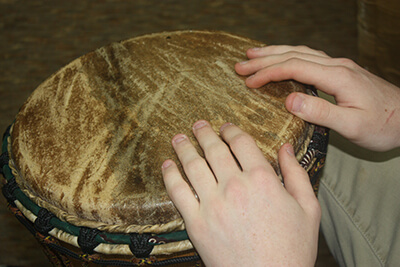 It is for this reason that Parmer expressed the importance of COSMOS, the crucial
part of the SPARK program that helps to find common ground between the youth and COE
students. All involved share defining moments in their pasts – positive and negative
– that have shaped who they are.
It is for this reason that Parmer expressed the importance of COSMOS, the crucial
part of the SPARK program that helps to find common ground between the youth and COE
students. All involved share defining moments in their pasts – positive and negative
– that have shaped who they are.
“We are trying to give them some type of release and motivation in the outside world that there’s something to look forward to,” explained Parmer. “When the college kids give their COSMOS, the teenagers see that they had similar struggles as them and realize that adult life can be enjoyable, despite current problems.”
All administrators involved in SPARK agree the biggest hurdle is logistics. Although the court highly recommends the program to juvenile offenders, it is not considered a condition of probation. Mainly, be it due to family or economic issues, transportation poses a problem.
“A lot of the kids don’t have a way to get to the program, especially consistently,” Parmer said. “If you have a kid in Villa Rica who has a single mother without a car, it’s hard to expect that child to get to UWG and back even once a week.”
Although the Coweta County branch of SPARK received a grant a few years ago for delinquency issues that allowed some money for transportation, it still remains a problem in Carroll County.
“We have talked a lot about trying to solve that transportation piece, but it would take money and resources,” Parmer confessed. “It’s easier said than done to get an entity to provide not only the cost of sending someone to get them, but the liability and supervision responsibility of it all.”
Any court or school could emulate the SPARK program according to Parmer, specifically larger counties. And while he’s quick to reiterate the program isn’t his brainchild, he is grateful for the opportunity to help expand it.
“I was blessed to have walked into a program that was already doing great things,” he concluded. “I will do anything to keep it moving forward.”
The parole officer
When Stephanie Love first heard about SPARK from the late Judge Dan Camp, he enthusiastically told her about a UWG professor he’d met who wanted to do a program with the at-risk youth of his court.
“I thought this was going to be a statistics professor who was all facts and numbers based,” said Love. “I meet him and he’s this fiery, determined man, and he tells us why he decided to start this group.”
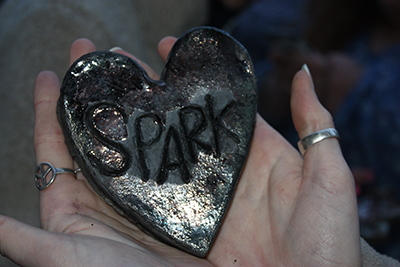 That impassioned professor was Peterson. He had recently met a distraught-looking
Camp who told him he’d seen more than 70 kids in court that day. Peterson was astonished.
That impassioned professor was Peterson. He had recently met a distraught-looking
Camp who told him he’d seen more than 70 kids in court that day. Peterson was astonished.
“He asked Judge Camp what the biggest problem was, and he said the spark was going out of these kids’ eyes,” Love recalled. “They have no hope. That’s where the name SPARK came from.”
As a juvenile parole and probation specialist of Carroll County’s Department of Juvenile Justice, Love primarily deals with youth who have been adjudicated on juvenile offenses. She said a lot of the adolescents she chooses to send to SPARK are college material – they just don’t know it yet.
“Usually my kids need socialization skills,” she informed. “A lot of them have nothing to do with their time.”
Love tells the teens ahead of time that SPARK isn’t like most programs they’re familiar with. Peterson neither forces the at-risk youth to be there nor tries to change them.
“People are so set on fixing,” she said. “The SPARK program is unique in that it doesn’t ‘fix’ them. It does something to them. It makes them feel different and cared about. They don’t expect people to care about them, they just expect people to try to change them. They change from the inside out on their own.”
Love, who has worked with SPARK since 2009, often talks to Peterson’s students before he picks volunteers. Watching and participating in the ins and outs of the program helps her appreciate the program even more.
“The college students get to see what they are about to walk into,” she concluded. “Dr. Peterson teaches them to look at those kids with awe and challenges them to do better. He allows a dialogue between the groups that they don’t get with the court system. They get to be open and say how they feel. It’s a learning experience for everybody.”
The college students
For the first time in years, Alexis Johnson was scared to go to school the next day.
“It was the night before our first time meeting the students who would be in the SPARK program,” said Johnson, a student in the College of Education who took Peterson’s class in spring 2018. “I was actually kind of scared because you hear terms like ‘at-risk youth’ and ‘troubled teens’ and I didn’t know what to expect. But the first time I walked in the room, I was put at ease immediately. The students were amazing and had a good attitude, considering what they were going through.”
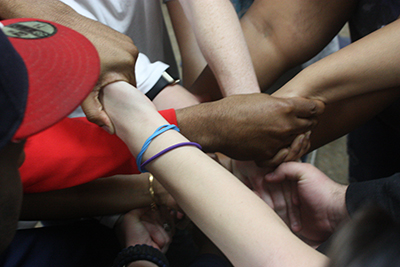 Johnson said she could see the teenagers just wanted a friend.
Johnson said she could see the teenagers just wanted a friend.
“It was so much easier than I thought it would be to just be friends with them and give them someone to talk to,” Johnson said. “It didn’t really feel like a mentoring program. It felt like I was just going to hang out with some friends.”
Johnson wasn’t the only spring 2018 student who didn’t know what to expect before the first SPARK meeting.
“I thought I would have to break up a fight every time we met,” said Chris Hollomon, a fellow COE student in Peterson’s class. “That didn’t happen, and it was a complete change from day one to the final time we met. There’s no way you could line up those teenagers and tell me they were the same person at the end of this experience as they were in the beginning.”
The best part of the SPARK program, Hollomon said, is that it’s not “magic in a bottle.”
“We aren’t doing anything magical or revolutionary,” Hollomon said. “We were just there to tell them that there are people who care about them and who will take time out of their days to listen to them. These are middle- and high-schoolers dealing with some very grown-up issues, and once you get to know their stories, you can’t help but be empathetic toward them.”
Most COE students cite the COSMOS presentations – during which they share their life’s story and any obstacles they’ve overcome in their personal lives – as a turning point during the program.
“After I shared my COSMOS, a student in the program came up to me and told me he was always there for me if I needed anyone,” said Kristen Rogers, another COE student in Peterson’s class. “I thought, ‘Isn’t this supposed to be happening the other way around?’ But this student told me the program created a family for us, and we were all brothers and sisters by the end of the semester. We’ll be there for each other for years to come, too. It was a short amount of time, but it created these lifetime friendships.”
Experiencing the SPARK program teaches COE students how to handle real-life situations they may not expect when entering the classroom.
“A lot of times we found that some teachers actually add stress to their students,” Hollomon said. “A child’s behavior can be a small, insignificant part of the larger issue. He may flip over a chair in class because his mom burnt him with a cigarette last night. They’re acting that way for a reason, and they don’t understand how to voice their opinion other than by acting out.”
Hollomon explained this can lead to a feeling of a child having no sanctuary.
“Instead of trying to figure out what’s going on, some teachers just label them as ‘bad kids’ and treat them as such,” Hollomon said. “So now, they’re getting mistreated at home and at school as well. They don’t have a sanctuary, but that’s what the SPARK program provides, for at least a short amount of time each week.”
Johnson agreed, saying she’ll be a better educator because of the SPARK program.
“It makes me upset to think about how some teachers across the country treat students who have been labeled as ‘bad kids,’ ” Johnson said. “The crazy part is that to act that way toward another person takes more effort than what we’ve done. All we did was give them an understanding ear to show them there’s someone out there who cares about them. I realized that if I didn’t have this experience, I could have easily been that kind of teacher who doesn’t listen to their students and just treats them like they’ll never amount to anything.”
Beyond being better educators after graduation, the college students said the program made them better people.
“We were able to connect with these teenagers, and we learned so much from them,” Rogers said. “We grew as people because we’ve never had that kind of experience before this. It put things into perspective in my own life, and made me more grateful, humble and kind.”
Posted on